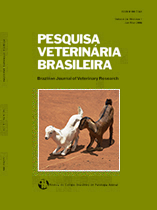 |
|
|
|
Year 2017 - Volume 37, Number 12
|

|
Susceptibility of two commercial lineages of broilers in the development of necrotic dermatitis and relationship of iss and iutA genes from Escherichia coli with the experimental reproduction of the disease, 37(12):1395-1400
|
ABSTRACT.- Carvalho D., Tejkowski T.M., Jaenish F.R.F., Rodrigues R.O., Brito K.C.T. & Brito B.G. 2017. [Susceptibility of two commercial lineages of broilers in the development of necrotic dermatitis and relationship of iss and iutA genes from Escherichia coli with the experimental reproduction of the disease.] Susceptibilidade de duas linhagens comerciais de frango de corte no desenvolvimento de dermatite necrótica e possível relação dos genes iss e iutA de Escherichia coli com a reprodução experimental da doença. Pesquisa Veterinária Brasileira 37(12):1395-1400. Laboratório de Saúde das Aves e Inovação Tecnológica, Instituto de Pesquisas Veterinárias Desidério Finamor, Fundação Estadual de Pesquisa Agropecuária, Estrada do Conde 6000, Eldorado do Sul, Sans Souci, RS 92990-000, Brazil. E-mail: benitobrito@gmail.com
Avian cellulitis is a disease of great importance for the global poultry industry, being mainly related to Escherichia coli. In this study the susceptibility of two lineages of broilers in the development of cellulite was compared to the challenge with different concentrations of E. coli. In addition, it evaluated the relationship of the iss and iutA genes with pathogenicity of E. coli samples from different origins (fecal/clinical cases) in chicks and with the experimental reproduction of disease in 35-day-old broilers. By inoculating broilers (Cobb/Ross) with different levels of challenge (105-108 CFU/mL) of E. coli, no significant differences had been observed between strains for sensitivity to necrotic dermatitis for the same dosage (p≤0.05). Detection of the iss and iutA genes showed that they were only present in samples from clinical cases. Likewise, these strains were considered high pathogenicity for chickens (>80% lethality), leading to the formation of more extensive lesion areas (≥3cm2) at 35 days of birds compared to the samples from fecal origin (p≤0.05). Still, the differences with respect to lesion size were also found among isolates of the same origin (p≤0,05). Thus, the lineage can not be considered a primary factor in the development of necrotic dermatitis in broilers. Furthermore, it is suggested that iss and iutA genes, when present together or separately, could be considered as virulence markers for E. coli strains that cause avian cellulite. |
| |
|
|
| |
|
 |